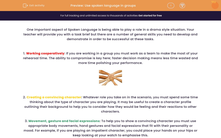One important aspect of spoken language is being able to play a role in a drama style situation. Your teacher will provide you with a task brief but there are a number of general skills you need to develop and demonstrate in order to be successful at these tasks.
1. Working cooperatively:
If you are working in a group, you must work as a team to make the most of your rehearsal time. The ability to compromise is key here - faster decision-making means less time wasted and more time polishing your performance.

2. Creating a convincing character: Whatever role you take on in the scenario, you must spend some time thinking about the type of character you are playing. It may be useful to create a character profile outlining their background to help you to consider how they would be feeling and their reactions to other characters.
3. Movement, gesture and facial expressions: To help you to show a convincing character you must use appropriate body movements, hand gestures and facial expressions that fit with their personality or mood. For example, if you are playing an impatient character, you could place your hands on your hips or keep looking at your watch to emphasise this.

4. Speech and use of voice: In order to achieve the best possible grade, you must speak at length and make significant contributions that can be clearly heard by the audience. You should also consider how your character would be speaking at different moments in the play to show their emotions, personality and relationship with other characters. For example, imagine you are playing a character who has found out they have won the lottery but then loses their ticket before claiming the money. How could you show their change of emotion from ecstatic hysteria to disbelief and grief when you speak?
5. Use of space: You need to consider how you are going to use the performance space to represent the setting for your play. Make group decisions on where you will all enter and exit the scene so everyone is walking through the same 'door', what scenery or props might be effective to use, and spacing, so everyone isn't acting in a tiny corner. You should also make sure that you never have your back entirely to the audience as your voice will trail off and your facial expressions won't be seen.

7. Staying in role: This is one of the most important things to remember! Whatever happens or goes wrong - carry on acting. Never come out of role to apologise for a mishap or collapse into a fit of the giggles. If you don't show that something has gone wrong, the audience will never know.
In addition to these points, there are also some drama techniques that you could use in your performance to create certain effects and to add variety:
- Freeze-frames: Freezing the action for a number of seconds, almost like someone has taken a still picture of a moment in the performance. These only work well if they are well rehearsed and when everyone is completely still for exactly the same amount of time before moving to their next position.
- Flashbacks: Performing a play in non-chronological order and having a series of flashbacks in the action to help the audience slowly piece together the story.
- Thought tracking: This is an effective technique when used alongside freeze-frames. One character at a time can come out of the frozen 'picture' and recount their feelings to the audience in a short monologue before returning to their still position.
- Slow motion: A good technique to add drama and tension where you slow the action right down. It can be particularly effective when set to fitting music.
- Cross cutting: Where you have two different scenes stopping and starting alternately on different parts of the stage. An example of how this could be used is a staged telephone conversation which would feature the two participants in different places. Freeze-frames and lighting effects can also be used here to help the audience to focus on the intended action at the right time.
There's an enormous amount to take in there so remember that you can look back at this introduction at any point by clicking the red help button on the screen.

Let's get started.








